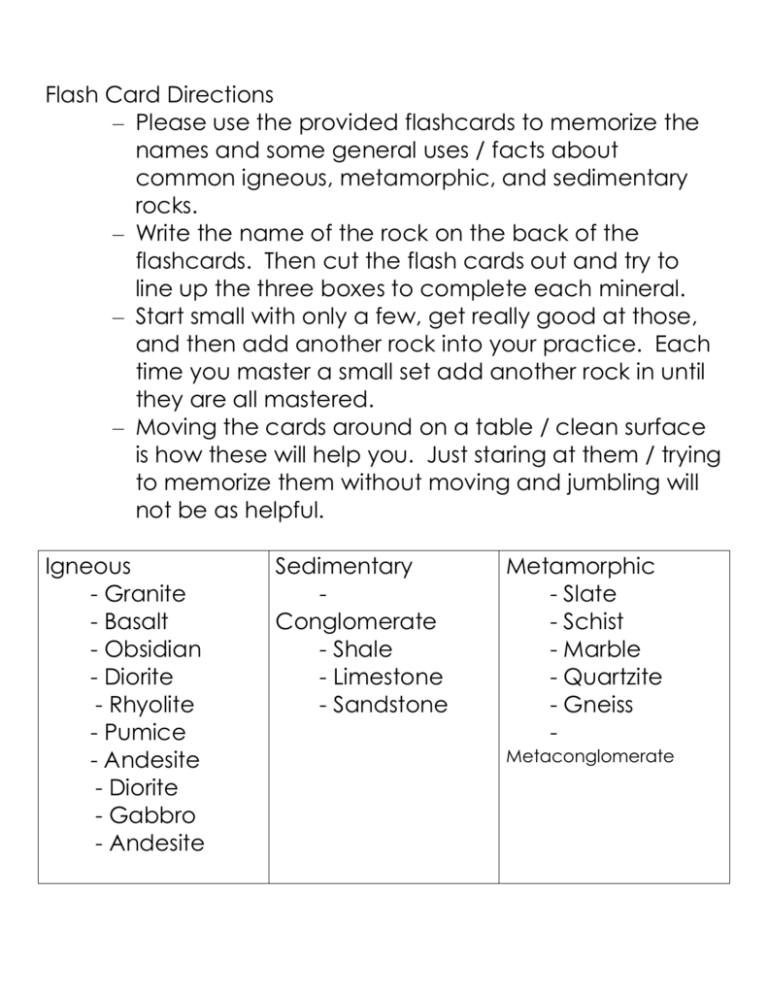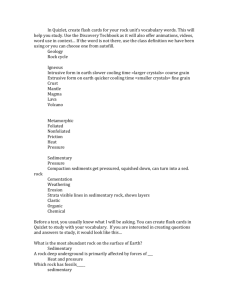Rock Flashcards
advertisement

Flash Card Directions – Please use the provided flashcards to memorize the names and some general uses / facts about common igneous, metamorphic, and sedimentary rocks. – Write the name of the rock on the back of the flashcards. Then cut the flash cards out and try to line up the three boxes to complete each mineral. – Start small with only a few, get really good at those, and then add another rock into your practice. Each time you master a small set add another rock in until they are all mastered. – Moving the cards around on a table / clean surface is how these will help you. Just staring at them / trying to memorize them without moving and jumbling will not be as helpful. Igneous - Granite - Basalt - Obsidian - Diorite - Rhyolite - Pumice - Andesite - Diorite - Gabbro - Andesite Sedimentary Conglomerate - Shale - Limestone - Sandstone Metamorphic - Slate - Schist - Marble - Quartzite - Gneiss Metaconglomerate Igneous Rock – Intrusive with large crystals. Composed mainly of quartz and feldspar. Igneous Rock – Dark Colored. Extrusive with fine grain crystals. Forms from cooled lava. Igneous Rock Forms when molten rock material cooled rapidly. The result is a volcanic glass. No crystals (usually) Igneous Rock – Intrusive, A coarsegrained rock that contains a mixture of feldspar, pyroxene, hornblende and sometimes quartz. Granite Basalt Obsidian Diorite Igneous Rock – Extrusive, A lightcolored rock. It forms through very rapid cooling. Igneous Rock – Extrusive, A finegrained rock composed mainly of plagioclase with other minerals such as hornblende, pyroxene and biotite. Igneous Rock – Intrusive, Coarsegrained, darkcolored. It is usually black or dark green in color. It is the most abundant rock in the deep oceanic crust. Igneous Rock – Extrusive, a lightcolored, finegrained rock that typically contains quartz and feldspar minerals. Pumice Andesite Gabbro Rhyolite Sedimentary Rocks Sedimentary, -Clastic Rock that contains large rounded clasts. The space between the clasts is generally filled with small particles that binds the rock together. Conglomerate Sedimentary, A fine-grained rock that forms from the compaction of silt and clay-size mineral particles “Mud” Shale Sedimentary Composed primarily of calcium carbonate – (Calcite), forms in marine waters and often has fossils. Limestone Sedimentary, clastic rock made up mainly of sand. Found in environments where large amounts of sand can accumulate. Sandstone Sedimentary Rock – Primary Mineral is Halite. Can form when water evaporates and leaves dissolved minerals behind. Rock Salt Metamorphic Rock Metamorphic – Foliated, is finegrained. Formed from shale and used for roofing and flooring. Metamorphic – Foliated, It often contains significant amounts of mica. Metamorphic, Nonfoliated rock that is produced from the metamorphism of limestone. It is composed primarily of calcium carbonate. Slate Schist Marble Metamorphic, Nonfoliated rock that is produced by the metamorphism of sandstone. It is composed primarily of quartz. A nonfoliated metamorphic rock with many stretched or distorted pebbles inside. Foliated metamorphic rock with banding. Medium to coarse grains. Minerals are segregated into bands. It’s such a nice rock. Quartzite Metaconglomerate Gneiss IN Ex Igneous Rocks cooled Inside the earth very slowly. Large crystals / Coarse grains. (Granite) Igneous Rocks cooled Outside the earth very quickly. Small crystals / fine grains. (Basalt) Intrusive Extrusive







